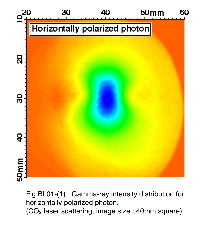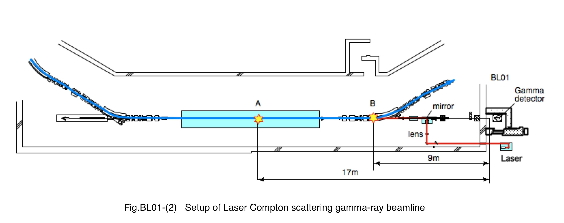
Facility


Purpose of the beamline
B0L1 is a beamline for developments of new light sources and their applications. At present, it is used to generate laser-Compton gamma rays of 1- 40MeV. These are generated by backward Compton scattering with relativistic electrons in NewSUBARU and photons from external lasers. The gamma ray beam is a very unique light source having the positive characteristics of tunable energy, quasi-monochromaticity, tunable polarization and beam directivity.
The gamma ray is used in various studies: photo-nuclear reaction, electron pair creation, nuclear transmutation and CT-imaging.
BL01

Layout of the BL01 is shown in Fig.BL01-(2). Nd:YVO4(wavelength 1µm、0.5µm) and CO2(wavelength 10.6µm) lasers are used. The lasers are set in the experimental hall and their beams are introduced by mirrors into the NewSUBARU ring. The Nd:YVO4 and CO2 laser beam is collided head-on into an electron beam at position (A) and (B), respectively. The generated gamma rays are used in the shielding hutch. NaI and plastic scintillation counters, a Ge detector, neutron scintillation and imaging plate are used for measurements and Linear Amp. Rate Meter and MCA are used for data acquisition.

| Laser | |
|---|---|
| Nd:YVO4 laser | wavelength 1.064µm, 5W : CW-100kHz (Pulse width 8ns) wavelength 0.532µm, 4W : 10kHz-100kHz (Pulse width 8ns) |
| CO2 laser | wavelength 10.52-10.57µm, 20W |
| He-Ne laser | beam alignment |
| Ti-Saf laser | plan |
Specifications of a mirror, collimator, spectrometer
Mirror
A mirror is set in the vacuum tube of the BL1 to introduce the laser beams. The generated gamma rays transmit through the mirror and the window, and are extracted into the shielding hutch.
Gamma ray collimator
Because energy of laser Compton gamma ray depends on its scattering angle, we can use quasi-monochromatic gamma ray by using only beam center with a collimator. The lead collimator with a 6 or 3mm diameter hole and 10mm thickness is set on a remote controlled X-Y stage.
Spectrometer
Gamma ray energy spectra can be measured by the Ge detector with MCA. The measured spectra represent the convolution of the detector response function with the gamma ray energy distribution. To obtain the original energy distribution, corrections by simulation are needed.
End station
There is a shielding hutch to use the gamma ray. Its side view drawing and photograph are shown in Fig.BL01-(3). A gamma flux of 6x106 photons/sec with energies of 6-17MeV is generated when the electron energy and current is 1GeV and 250mA respectively, and the laser power of Nd laser (1µm) is 4W. In the hutch, the gamma ray beam size is 10mm at a distance of 19m from the collision point without the collimator. Sample targets should be placed inside the hutch and the gamma ray must be irradiated them with closing the hutch door.

Spectra
Gamma ray spectra with Nd laser(1.064µm) BL01-(4)and
Angle distributions of gamma energies BL01-(5).


Available gamma ray flux
| Laser | wavelength | Gamma photon energy* | Normalized Flux |
|---|---|---|---|
| Nd:YVO4 laser | 1064nm | 16.7MeV | 6000γ/s/mA/W |
| 532nm | 33.4MeV | 3000γ/s/mA/W | |
| CO2 laser | 10520nm | 1.7MeV | 7000γ/s/mA/W |
*Maximun photon energy atθ=0 with a electron energy of 974MeV.
The gamma ray flux is 6000γ/s/mA/W x 250-mA x 4W = 6x106 γ/s, with a bean current of 250mA and an incident laser power of 4W.
Applications
Studies using laser-Compton gamma ray

Other equipments
General equipments in the BL01
To observe SR and Laser spectra, VUV and IR-Visible monochromatos can be used.
| VUV:PC-controlled 0.2m vacuum monochromator (ARC Model VM-502) | |
|---|---|
| Grating | 1200G/mm |
| Resolution | 0.3mm |
| Range | 30-300nm |
| Vacuum | 10E-7 Torr |
| IR~Visible:PC-controlled 0.5m monochromator (ARC Model SP-5001) | |
|---|---|
| Grating | 1200G/mm |
| Resolution | 0.15mm |
| Range | 200-12000nm |
Electronics
digital-ocsiloscope, high-voltage supply, linear amp., discriminator
rate meter, counter, divider, delay pulser, MCA(multi-channel Analyzer), TV camera, monitor




